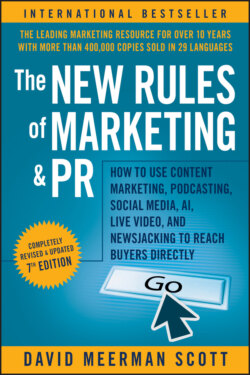Читать книгу The New Rules of Marketing and PR - David Meerman Scott, Kevin Nalty, Steve Garfield - Страница 46
Staying Connected with Members and the Community
ОглавлениеAs the demographics of the United States have changed over the past several decades, many mainline church organizations have struggled to attract and maintain members. Like any business or nonprofit, the churches that succeed are those whose leaders understand the problems buyers (here: churchgoers) face and use the power of publishing valuable information to reach them directly. Trinity Cathedral7 in Cleveland is a place where ancient church practice has blended with new patterns of social interaction to build a vibrant community both online and offline. Trinity Cathedral is a historic landmark and home to a vibrant, inclusive congregation in the heart of a city struggling to revitalize after decades of decline in manufacturing jobs. The Very Rev. Tracey Lind, dean of Trinity Cathedral, leads the effort.
“The official way you count attendance or membership in the Episcopal Church is to count average Sunday attendance,” Lind says. “For a long time, I and a group of my colleagues have been saying that’s not an accurate measure of the work we’re doing. In fact, our vitality would be better measured by average weekly touch.” To touch people regularly outside of Sunday services, Lind publishes an email newsletter, her own blog,8 audio podcasts, a Facebook page, and a Twitter feed. “Reality is that most people don’t go to church every week anymore,” she says. “That’s just a reality of life. My attitude is that you can fight it, or you can be a part of it.”
Lind’s publishing efforts help create a virtual community within the congregation. Trinity Cathedral employs a full-time communications person and also relies on Rebecca Wilson and Jim Naughton of Canticle Communications (a firm that serves mainly church organizations) to help with web design and content publishing efforts. “We do everything as if we are running a web business to try to attract people to us,” Lind says. “The reality is I’m not going to get everybody to church every week. If you can’t get to church on Sunday, you can listen to the service on a podcast or you can read it on my blog. If you’re teaching our kids or you’re singing in the choir or doing something else at that hour, you can listen to it on a podcast. What we find is we’re reaching huge communities of people [with] our podcasting. People are listening to us all over the globe. I get emails from folks in Australia or Germany, thanking me for a sermon that I preached and wanting to engage.”
Music is a particularly important aspect of Trinity Cathedral’s podcasting efforts. “If you go to England, one of the things that people do is go to the great cathedrals to attend choral Evensong to listen to the men’s and boys’ choirs sing,” Lind says. “Well, we do that at Trinity every week, and we think there’s nobody in the country podcasting choral Evensong. So we started podcasting that, which is a way of making us unique. People listen to really extraordinary choral music every week, and they count on the podcast.”
Marketers at companies whose buyers include a segment of older people frequently assume that the elders are not online and that they won’t engage with a web publishing effort. I’ve always pushed back on this notion. So does Lind, who has demographic data to show how misguided those conventional ideas can be. “We find that in our 1,000-member congregation, all but about 10 adults are on the Internet,” she says. “Only 10 adults are not using the web, and that includes our elders. Most of our elders are actively social networking and on the Internet. When we suspended our print newspaper, I got just one complaint.”
Trinity Cathedral attracts a very diverse group of people in the Cleveland area, and the web publishing efforts aid in building the community of people who become members. “Our market is clear,” Lind says. “We’re trying to attract progressive people of faith who are concerned about the city and who want to be a part of an intentionally inclusive, diverse, engaged congregation. We’re trying to attract change agents. We’re intentional about trying to attract the 20s and 30s, but there’s also great value in the world of the empty-nesters, and also in the ‘third half of life’: boomers, those reinventing aging. I think of one of our audiences as those who listen to NPR—thoughtful, but not necessarily highly educated. We attract a lot of really thoughtful working-class folks that you wouldn’t otherwise think would be coming. We’re racially diverse. We are always interested in families that are wanting something other than the bland suburbs for their kids—so a lot of alternative families, blended families, adopted families, LGBT families, single moms, single dads.” Lind considers each of these markets as she creates information to publish on the web.
Developing and maintaining the publishing program at Trinity Cathedral is a major effort for an organization tight on resources. But reaching buyers through the blog, podcasting, social networking, and the email newsletter is essential, given the changing ways people relate to their churches. Just like so many leaders of for-profit businesses, Lind has had to convince stakeholders of the importance of online marketing. “When I got to Trinity, there was one computer in the place, and it was barely used. That was in 2000. Part of the dilemma is the amount of money that has to go into communications, which is an enormous paradigm shift for churches. Frankly, my communications director is as valuable as a priest. That is a shift that is sometimes hard to explain to people.” But it’s one that will be essential for traditional churches to understand if they are to survive and thrive in the age of the social networks.
